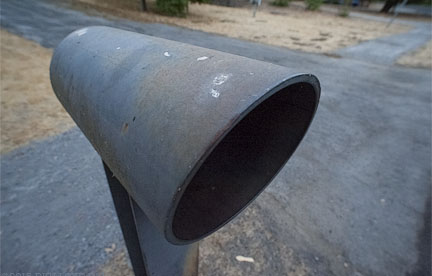

|


|

$200 Leica BP-SCL6 Lithium-Ion Battery (8.4V, 2200mAh) BACK IN STOCK in Accessories: Batteries and Power
|

|

|

|
IN STOCK!
For Sony mirrorless or Leica L.
Understand Perspective and Size Variance
Perspective (the relative size of objects in relation to each other) is governed only by the distance to the subject.
The image of my mailbox below is not deformed, it’s just the result of honest rendering of its optical size front-to-back relative to the camera, a reality equation our brain largely hides from us with the size invariance principle: things stay about the same size within a relatively wide range of distances. Visual cues matter; this is (mostly) why the moon looks huge on the horizon.
In this case, the front of the mailbox is about twice as close to the lens as the rear, which it means its image really is about four times as large (2X2). Hint: most women don’t like their faces be photographed up close with an 18mm lens (though other body parts might benefit for some).
This image shows the inverse square law: the apparent size of the mailbox shrinks as distance from the camera increases. Our eyes (brain) compensate for this reality.

NIKON D3 + unspecifiedLens @ 18mm
[low-res image for bot]
Here, the telephoto compression effect comes from a substantial shooting distance, not because the lens is a 200mm telephoto.

Canon EOS 5D Mark III + Canon EF 200-400mm f/4L @ 200mm
[low-res image for bot]
Reader Sohail K writes:
I wonder if you could clear up an issue about lens “perspective" on a cropped sensor. Take for instance a 17.5mm lens on a MFT sensor: as you know it’s often said to be the equivalent of a 35mm (on a full-frame sensor) and have a 35mm perspective. Some argue that such a lens can only ever have 17.5mm perspective -- even on a cropped sensor. What exactly is the truth here?
More practically, can these differences in perspective be discerned by a trained eye? i.e. between a true 35mm perspective (on full-frame sensor) and a 17.5mm on a MFT?
What about the question of compression? That is, an image can have the same field of view but a different degree of compression, hence a different perspective, no? Or am I missing something here?
DIGLLOYD: Perspective and “telephoto compression” are both a function of camera to subject distance (only). Neither has anything to do with the focal length or format size (35mm full frame or DX or MFT or medium format): at the same distance (lens entrance pupil to subject), one chooses the appropriate focal length for the format to achieve the same field of view, which thus has identical perspective.
To see that this is so, frame any subject with different focal lengths or camera formats (swap lenses, e.g., a 24mm, 50mm, 100mm, keep the camera fixed in place). Crop the results as needed to show the same angle of view. The perspective will be identical (but close range shooting requires matching the distance to the entrance pupil, so shoot at distance). There will be subjective differences related to optical design, but those are not perspective related.
It is physics: the inverse square law determines the relative sizes of objects.That said, the human brain plays all sorts of games to make our visual system more useful to us, which is one reason why the moon looks huge when it rises (the size invariance principle). Book: Perception and Imaging, by Richard Zakia @AMAZON.
Related: Format-Equivalent Depth of Field and F-Stop in MSI.
Format equivalence—use of a 50mm lens on 35mm full frame means use of a ~33mm on a DX crop sensor to achieve the same field of view from the same position (on MFT, it would be a 25mm). If one instead uses that same 50mm on the DX crop-sensor camera, then it becomes necessary to move away from the subject, and that is what changes the perspective (the distance). Focal length by itself does not imply any particular angle of view; it is only when a format size is specified that the focal length has a context for field of view.
There are effects of optical design and focal length that influence various rendering qualities including the sharp-to-blur gradient, but these have nothing to do with perspective or telephoto compression. See The Medium Format 'Look' in Guide to Zeiss for some insight into these matters.




















